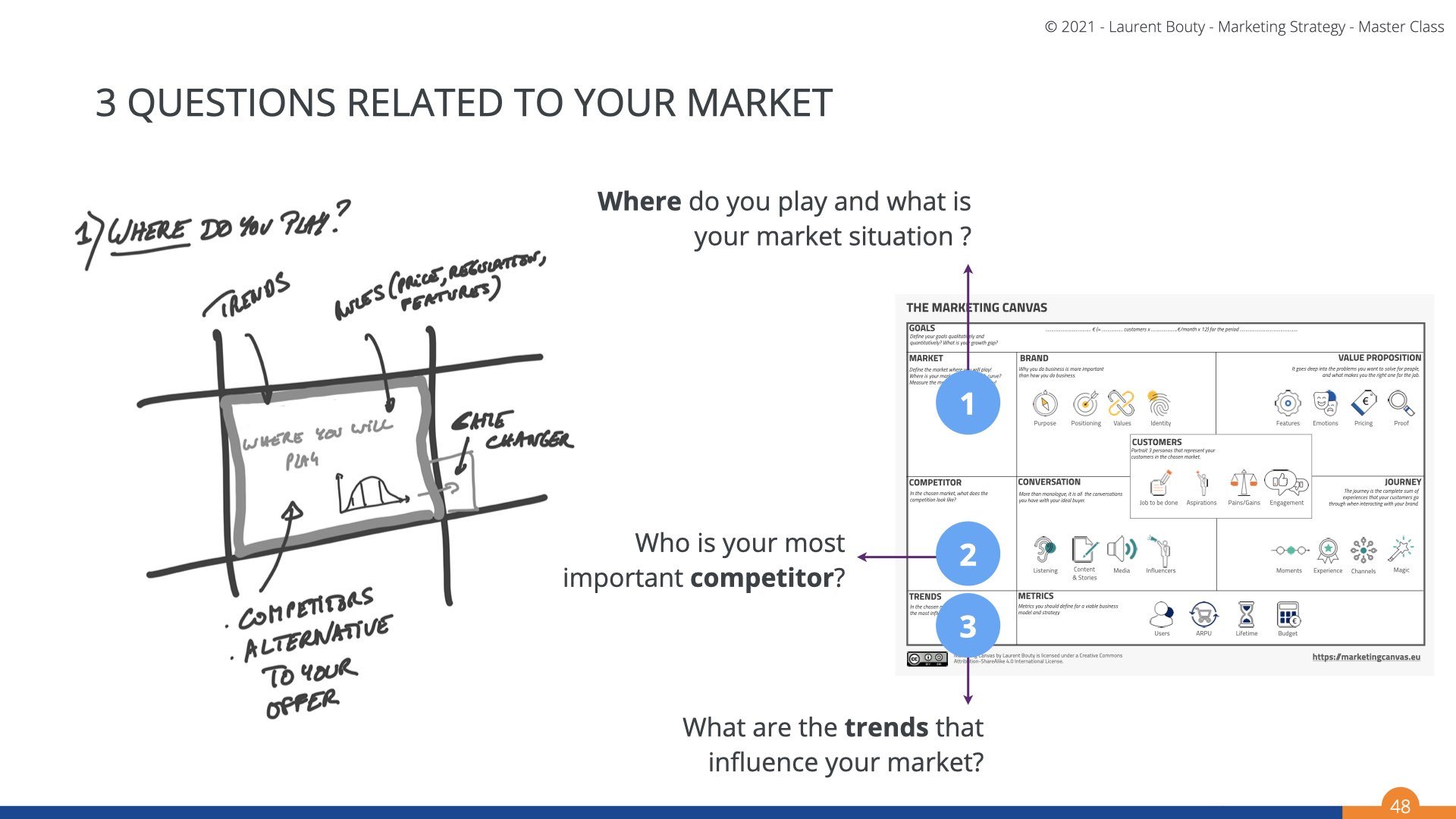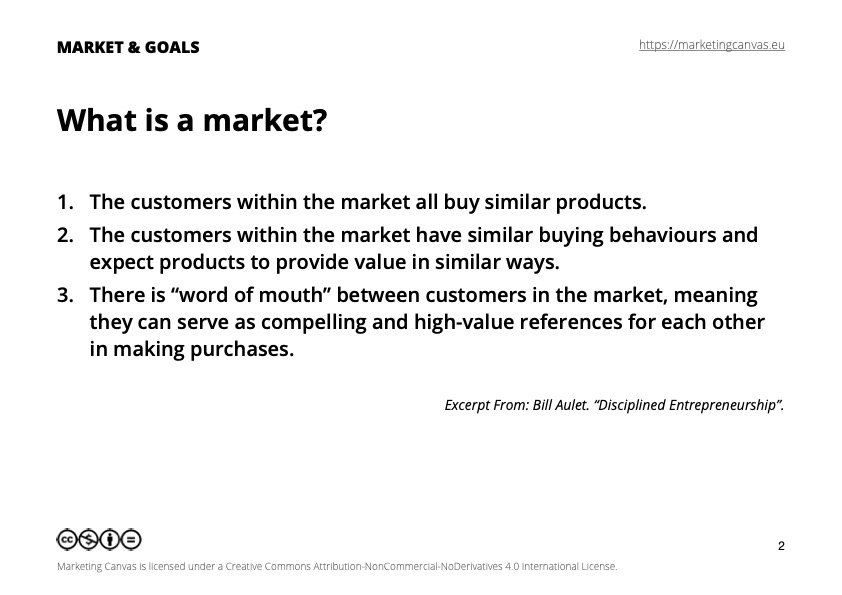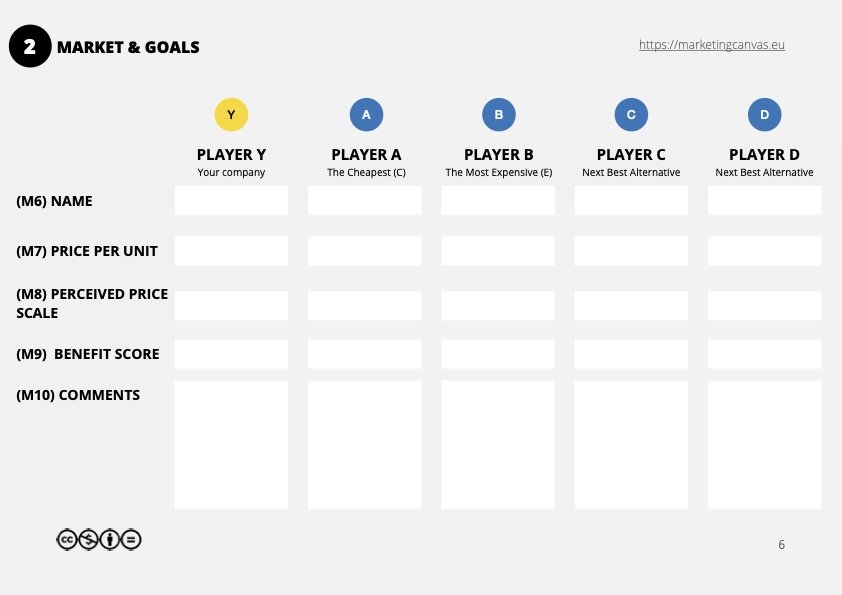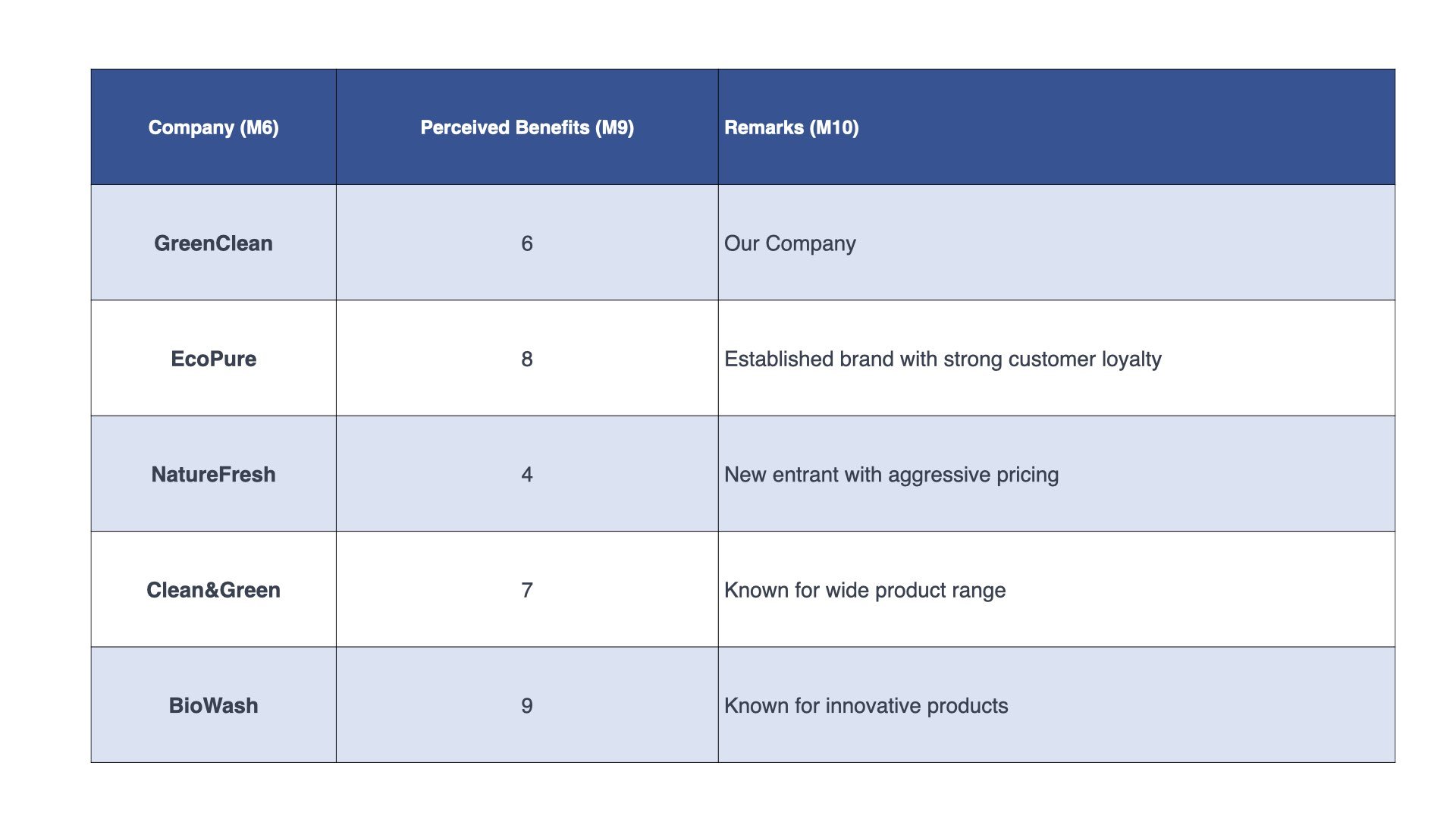Last update: 12/05/2023
Introduction
Understanding the concept of a 'market' is fundamental to crafting a successful marketing plan. But what does 'market' truly mean in a marketing context?
When you introduce products or services to fulfill specific needs, there's a high probability that alternatives already exist. These alternatives set a frame of reference for customers, leading them to compare your offerings against what they know:
Is it more expensive or cheaper?
Does it offer more or less perceived benefits?
Why should they switch to your product?
Three Crucial Questions for Your Market
Question 1: What is your playing field, and how would you describe your market dynamics?
In marketing, we often segment territories into groups exhibiting similar characteristics, referred to as 'market segments' or 'markets'. This segmentation streamlines sales efforts, as your primary goal becomes convincing customers within your targeted market to choose and retain your value proposition.
I rely on Bill Aulet's definition (Excerpt From: Bill Aulet. "Disciplined Entrepreneurship") to clarify what constitutes a market:
Customers within the market purchase similar products.
Customers within the market exhibit similar buying behaviors and anticipate similar value from the products.
There's "word of mouth" among customers in the market, meaning they serve as high-value references for each other in making purchases.
To illustrate, consider these examples:
Buying a car or a computer places you in the Car market and Computer market respectively. These markets align with Aulet's definition.
If you're a strategic consulting firm or a law firm, there likely exists a market for strategic consulting services and a market for legal services, respectively. Again, these markets align with Aulet's definition.
This concept of a market applies to both consumer and business services. Moreover, markets can be subdivided into sub-markets, providing a finer granularity to develop a marketing strategy. For instance, the Car market can be split into SUV and Sedan sub-markets, and the Computer market into Laptop and Desktop markets.
This subdivision forms a crucial step in devising a marketing strategy as it allows for an improved understanding of the context. The silver lining is that this work is often already accomplished, and markets are defined by the existing players. A wealth of data and statistics on different markets can be found on the internet, available free or for purchase.
Remark: you can compete in different markets, however the marketing canvas method has been designed for one market as competitors and conditions might change between markets. In case you would like to analyse multiple markets, you should do it one by one and then consolidate all the assessments in one strategy.
Case Study: Green Clean
Consider the eco-friendly cleaning products market. Companies like Method, Ecover, Seventh Generation, Mrs. Meyer's, and Green Clean offer alternatives to traditional cleaning products. They all compete within the eco-friendly cleaning products market, defined by customers' preference for environmentally conscious choices, similar buying behaviors, and the potential for word-of-mouth recommendations. These companies have different pricing strategies and perceived benefits, which customers will compare before making a decision.
CASE STUDY: Tesla Model S
Consider the Tesla Model S. It belongs to the broad market of cars, but we can further narrow this down into sub-markets. A common mistake is to categorize the Tesla Model S under the market of electric cars. However, being electric is a feature, not a market. Although both a Toyota Prius and a Tesla Model S are electric cars (one being a hybrid), they do not belong to the same market. The Tesla Model S fits into the Luxury E automobile or Executive/Mid-size luxury market, which also includes vehicles like the Porsche Taycan or the BMW 5 series.
As we delve deeper, we'll discover that once we have identified the market where our value proposition will compete, it's crucial to understand and follow a set of rules to shape our commercial strategy.
After identifying your company's competitive market, we need to delve into the specifics. Just like a painter cannot create art without understanding their canvas, a marketer cannot formulate a strategy without understanding their market.
1.1 Market Definition (M1)
To define your market, you must understand what product or service you are selling and who will likely buy it. For example, if you're selling eco-friendly cleaning products, your market might be environmentally conscious homeowners.
1.2 Key Expected Benefits (M2)
This involves identifying what the players in the market hope to gain. This includes both functional benefits (e.g., eco-friendly cleaning products that effectively clean the house) and emotional benefits (e.g., feeling good about contributing to environmental conservation).
1.3 Market's Position on Growth Curve (M3)
Every market undergoes stages: introduction, growth, maturity, and decline. Understanding where your market is on this curve helps you strategize accordingly. For instance, an emerging market might require more education and awareness efforts.
1.4 Experience Economy Curve of the Market (M4)
This refers to how the market evolves from selling simple commodities to providing sophisticated experiences. For instance, coffee can be sold as a commodity (beans), a product (packaged coffee), a service (brewed coffee in a cafe), or an experience (gourmet coffee tasting).
1.5 Total Available Market (TAM) and Serviceable Available Market (SAM) (M5)
TAM is the total market demand for a product or service, while SAM is the segment of TAM targeted by your company's products and services within your geographical reach. These metrics help assess the market size and opportunity.
Question 2: who is your main important competitors?
Identifying and analyzing your competitors is just as crucial as understanding your market.
2.1 Competitors' Identification (M6-M10)
Identify up to five main competitors in your market. For each, identify the product price per unit (M7), perceived price (M8), perceived benefits (M9), and any additional remarks (M10).
2.2 Perceived Price (M8)
Perceived price is a metric that reflects how customers perceive your price relative to the competition. It is not always about the actual cost but rather the perceived value for money. The perceived price is calculated using a formula: M8 = 24/(E-C) * (M7-C) - 12.
Here, E is the maximum price per unit in the market, C is the lowest price per unit, and M7 is your product's price per unit. The calculation generates a score on a scale of -12 to +12, helping you understand your product's perceived price positioning in comparison to competitors.
Let's consider an example in the eco-friendly cleaning products market. We'll analyze five companies: GreenClean (our company), EcoPure, NatureFresh, Clean&Green, and BioWash.
Here's the calculation for GreenClean's perceived price:
M8 = 24/($15-$6) * ($10-$6) - 12 = 24/9 * 4 - 12 = 10.67 - 12 = -1.33
The same calculation is applied to find the perceived prices for the rest of the companies. This table helps you understand how your product's price is perceived relative to the competitors in the market.
In this case, GreenClean's price is perceived to be lower than most of its competitors, which can be an advantage if customers are price sensitive. However, you also need to ensure that the lower price doesn't lead customers to perceive it as lower quality.
2.3 Perceived Benefits (M9)
This is a measure of the benefits a customer perceives when interacting with a company. The perceived benefit score is calculated by summing up the scores of four questions related to the Brand, Value Proposition, Customer Journey, and Conversations offered by the company in the chosen market.
Here's how to handle each question:
Brand Perception: Ask yourself, "Is the company's brand the highest perceived amongst all the alternatives in the market?" This isn't just about brand recognition; it's about the positive associations customers make with your brand. It could be related to quality, trust, innovation, or social responsibility.
Value Proposition: Consider, "Is the company's value proposition the highest perceived amongst all the alternatives in the market?" The value proposition is the unique mix of product, price, placement, and promotion that the company offers. It answers why a customer should buy from you rather than your competitors.
Customer Journey: Query, "Is the company's customer journey the highest perceived amongst all the alternatives in the market?" The customer journey comprises all interactions between the customer and the company. It can include the ease of navigating your website, the clarity of product information, the efficiency of the checkout process, after-sales service, and more.
Conversation: Reflect on, "Is the company's conversation the highest perceived amongst all the alternatives in the market?" Conversations refer to the communication between the company and its customers. This could include advertising messages, social media interactions, customer service interactions, and more.
For each of the four questions, rate your agreement on a scale of -3 (completely disagree) to +3 (completely agree). Sum up these ratings to derive the Perceived Benefits score (M9).
This score gives you an understanding of your company's strengths and areas of improvement from the customer's perspective. It provides insights into how you can enhance your customers' experience, strengthen your value proposition, and ultimately, increase your market share.
These perceived benefits scores indicate how each company's offerings are viewed in the market. GreenClean, for instance, scores fairly well, suggesting its customers appreciate its brand, value proposition, customer journey, and conversations. However, there's room for improvement, especially when compared to competitors like EcoPure and BioWash. This analysis can help guide strategic decisions to improve these areas and enhance customer perception.
question 3: what are the trends influencing your market?
This stage involves compiling all the information gathered above and creating a comprehensive view of your market.
Describe your chosen market, ensuring it aligns with the market definition of Bill Aulet.
Fill in a template (template #2) with information on your company and a maximum of 4 other companies.
Identify the average unit price for the company value proposition in the market (M7).
Map this average price for all companies using the formula: M8= 24/(E-C)*(M7-C)-12.
Calculate for each company the Perceived Benefits M9 by summing up the results of the 4 questions.
Map these results on a graph with perceived benefits (M9) on the horizontal axis (scale -12 to + 12) and perceived prices (M8) on the vertical axis (scale -12 to +12). This visualization (template #4) gives a clear picture of where each competitor stands in terms of value for money in the eyes of customers.
In conclusion, the market you're operating in, or planning to penetrate, defines the rules of the game. Understanding these rules, and how to play within them, will significantly influence your chances of success.
Whether it's the luxury electric car market or the eco-friendly cleaning products market, your marketing strategy should be rooted in a deep understanding of the market dynamics. This includes not only identifying your competitors but also comprehending the perceived price and benefits that your product or service brings to the table.
Marketing Canvas Method - Market Assesment Process
Tips for non-marketers and entrepreneurs
1. Stay Curious: Regularly research and keep up with trends in your market. It's not a one-time activity but a continuous process.
2. Talk to Customers: They can provide valuable insights that even the most sophisticated analysis might miss. Regular feedback from customers is a goldmine of information.
3. Keep an Eye on Competitors: Competitors can provide valuable lessons. Their successes and failures can provide insights for your own strategy.
4. Iterate: A marketing strategy is not set in stone. It evolves with your business, market trends, and customer preferences. Regularly revisit and update your strategy based on new data and insights.
Remember, understanding the context is just the first step in the marketing canvas method. It sets the foundation for the other steps in the process, guiding the direction of your marketing strategy.
























